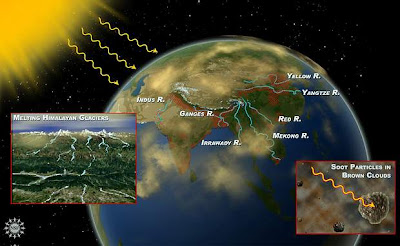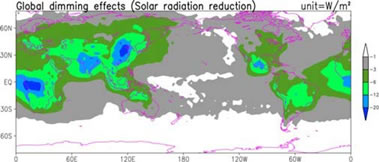Air Pollution ABC - nicht in Australien

Global dimming is the gradual reduction in the amount of global direct irradiance at the Earth's surface that was observed for several decades after the start of systematic measurements in 1950s. The effect varies by location, but worldwide it has been estimated to be of the order of a 4% reduction over the three decades from 1960–1990.
Gigantische braune Wolken verändern das Weltklima
Florian Rötzer 15.11.2008 - Telepolis.de
Die von Menschen verursachten Wolken bedecken vor allem Asien, aber auch Teile von Südafrika, Europa, Nordamerika und dem Amazonasbecken
Gewaltige, von Menschen verursachte Dreckwolken aus giftigen Chemikalien, Ruß und Smog bedecken den Himmel über weiten Teilen von Asien und beeinflussen dort das Klima. Eine drei Kilometer dicke "braune Wolke" erstreckt von der Arabischen Halbinsel über China bis zum Pazifischen Ozean, warnt ein ![[extern]](http://www.heise.de/tp/r4/icons/inline/extlink.gif) Bericht des Umweltprogramms der Vereinten Nationen (
Bericht des Umweltprogramms der Vereinten Nationen (![[extern]](http://www.heise.de/tp/r4/icons/inline/extlink.gif) UNEP). Die Wolke führt dazu, dass die Städte dunkler, die Gletscher im Himalaya schneller abschmelzen und die Menschen erkranken.
UNEP). Die Wolke führt dazu, dass die Städte dunkler, die Gletscher im Himalaya schneller abschmelzen und die Menschen erkranken.
Autoabgase, Brandrodung, Holzfeuer und Kohlekraftwerke tragen zur Bildung der braunen Wolken in der Atmosphäre bei (Atmospheric Brown Clouds - ABCs), die vor allem Asien, aber auch Teile von Südafrika, Europa, Nordamerika und dem Amazonasbecken bedecken. Veröffentlicht wurde der Bericht in Peking, die als eine der Megacities mit der größten Luftbelastung gilt.
Die anderen Städte, die als besonders gefährdet gelten, sind Bangkok, Kairo, Dhaka, Karachi, Kolkata, Lagos, Mumbai, New Delhi, Seoul, Shanghai, Shenzhen und Teheran. In der Luft dieser Megacities findet man 10 Prozent der Gesamtmenge aller von Menschen verursachten Partikel. In der chinesischen Stadt Guangzhou ist der Lichteinfall durch die Dreckwolken seit den 70er Jahren um 20 Prozent geringer geworden. Allgemein wird das Licht in den betroffenen Städten zwischen 10 und 25 Prozent gedimmt. In ganz China wurde das Licht seit den 50er Jahren zwischen 3 und 4 Prozent pro Jahrzehnt gedimmt, in Indien um 2 Prozent seit den 60er Jahren. Allerdings ist in den letzten Jahren die "Verdunkelung" schneller angestiegen.
Es sei höchste Zeit zu handeln, mahnt UNEP-Direktor Achim Steiner bei der Vorstellung. Die reichen Industrieländer müssten den Entwicklungs- und Schwellenländern dabei helfen, die Luftverschmutzung einzudämmen. Das würde nicht nur die Klimaerwärmung bekämpfen, sondern auch die gesundheitlichen Folgen für die Menschen reduzieren. Die Ursache der ABCs sei in aller Regel dieselbe wie die der Treibhausgase, sagt Steiner: das Verbrennen von fossilen Treibstoffen und Biomasse sowie die Entwaldung.
Die Ruß-, Kohle- und Schwefelstoffpartikel und die anderen chemischen, teils giftigen Substanzen, die die braunen Wolken bilden, "maskieren" die Klimaerwärmung, weil sie das Sonnenlicht reflektieren und die unter den Wolken liegenden Regionen abkühlen. Die aktuelle Erwärmung werde zwischen 20 und 80 Prozent abgeschwächt. Die Partikel und Aerosole in den ABCs können die Bildung von Regentropfen erschweren. Daher halten sich die Wolken länger und regnet es weniger. Würde der Klimaeffekt der ABCs plötzlich beendet werden können, dann gehen die Wissenschaftler davon aus, dass die globalen Temperaturen um bis zu 2 Grad Celsius steigen würden. Daher könnte es riskant sein, nur die Bildung der braunen Wolken zu bekämpfen, ohne gleichzeitig die Emission von Treibhausgasemissionen massiv zurückzufahren,
Was vielleicht als ein nicht bewusst praktiziertes Geoengineering erscheinen mag, führt jedoch durch Veränderung des Wetters zu erheblichen Folgen. So wird es in Nordchina immer trockener, während in Südasien die Flutgefahr wächst. Die Monsunregenfälle in Indien und Südasien sind seit 50er Jahren um 7 Prozent zurückgegangen, insbesondere werden die Niederschläge im Sommermonsun geringer. In China und Asien sind extreme Niederschläge insgesamt häufiger geworden. Die Erwärmung der Atmosphäre durch die ABCs wird neben der Klimaerwärmung durch Treibhausgase für den "anormal hohen Erwärmungstrend in den erhöhten Gebieten" wie der Himalaya-Region verantwortlich gemacht.

Welche Auswirkungen der von den ABCs verursachten Erwärmungs- und Abkühlungseffekte hat, ist nach Angaben der Wissenschaftler ohne weitere Forschung noch nicht wirklich auszumachen. Allerdings gehen sie von vielen, auch dramatischen Folgen aus, auch in Zusammenwirken mit den Treibhausgasemissionen. So könnte die Ernte durch die Zunahme des Ozons am Boden geringer werden – und zwar zwischen 10 und 40 Prozent. Aufgrund der Verdunkelung könnte die Photosynthese eingeschränkt werden, was auch zu einem geringerem Wachstum der Pflanzen beiträgt. Und die giftigen und säurehaltigen Partikel könnten die Pflanzen schädigen.

Die giftigen Aerosole, Carzinogene und andere Partikel wie Feinstaubpartikel, die kleiner als 2,5 Mikron sind, beeinträchtigen auch die Gesundheit der Menschen und können zu zahlreichen Krankheiten führen, vor allem zu Atemwegs- und Herzkreislauferkrankungen. Allein die größere Aussetzung an solche Feinstaubpartikel außerhalb von Gebäuden könnte zu 349.000 zusätzlichen Todesfällen im Jahr in China und Indien führen. 780.000 Todesfälle jährlich in beiden Ländern werden von der WHO bereits jetzt mit der Verwendung von Festbrennstoffen in Innenräumen in Verbindung gebracht.
http://en.wikipedia.org/wiki/Global_dimming
The incomplete combustion of fossil fuels (such as diesel) and wood releases black carbon into the air. Though black carbon, most of which is soot, is an extremely small component of air pollution at land surface levels, the phenomenon has a significant heating effect on the atmosphere at altitudes above two kilometers (6,562 ft). Also, it dims the surface of the ocean by absorbing solar radiation.
Experiments in the Maldives (comparing the atmosphere over the northern and southern islands) in the 1990s showed that the effect of macroscopic pollutants in the atmosphere at that time (blown south from India) caused about a 10% reduction in sunlight reaching the surface in the area under the pollution cloud — a much greater reduction than expected from the presence of the particles themselves.
The Asian brown cloud is a layer of air pollution that covers parts of the northern Indian Ocean, India, Pakistan, and parts of South Asia, Southwest Asia, and China. Viewed from satellite photos, the Cloud appears as a giant brown stain hanging in the air over much of Asia and the Indian Ocean.
In some humidity conditions, it forms haze. It is created by a range of airborne particles and pollutants (e.g. woodfires, cars, and factories), characteristic of biomass burning and industrial emissions due to incomplete burning. The cloud is associated with winter monsoon (December to April) during which there is no rain to wash pollution from the air. It is now known as the Atmospheric Brown Cloud.
This pollution layer was observed during the Indian Ocean Experiment (INODEX) intensive field observation in 1999. Subsequently the United Nations Environment Programme (UNEP) has been supporting a project called ABC (still ongoing in 2007). The brown clouds are also thought to be a cause for the depletion of crops in some areas.

Although aerosol particles are generally associated with a global cooling effect, recent studies have shown that they can actually have a global warming effect in certain regions such as the Himalayas. The warming effect of the Asian Brown Cloud may be an important factor in the retreat of the Himalayan glaciers. The United Nations Environment Program is worried that Asian glacial melting could lead to water shortages and floods for the hundreds of millions of people who live downstream.
A recent CSIRO study found that the Asian Brown Cloud is also affecting rainfall in Australia.
Le nuage brun d’Asie est un immense nuage de pollution d’environ 3 000 mètres d’épaisseur, s’étendant sur une surface équivalente à celle des États-Unis. Cette épaisse couche de brume est considérée comme la plus grosse pollution au monde
|
|
http://www.unep.org/Documents.Multilingual/Default.asp?DocumentID=550&ArticleID=5978&l=en
 Stumble It!
Stumble It!











0 Comments:
Post a Comment
<< Home